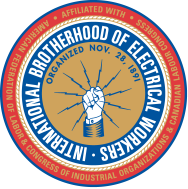*This article was originally published in the November 2024 issue of The Electrical Worker Online
The First District’s increased emphasis on organizing throughout Canada earned several honors at the Membership Development Conference in Chicago in August, including largest overall growth during the last year.
The district added 2,907 members between Aug. 1, 2023, and July 31, 2024, the most of any of the IBEW’s 11 districts. It also added the most BA members during that period, with 481. BA members typically work for a single employer with negotiated pension and benefits.
During the last two years, the First District has added about 4,900 members throughout Canada, increasing overall membership to about 67,000 after several years of declining numbers.
First District International Vice President Russ Shewchuk noted that 46 signatory contractors were added in the construction branch during the last year, which is primarily composed of A members. Twelve new units earned representation in the professional and industrial, or P&I, sector, which is primarily composed of BA members.
“To me, a big part of organizing is about bringing more contractors into the fold,” he said. “That provides more market share and gives new contractors a chance to expand their business and put our brothers and sisters to work.”
The First District also was recognized for being one of seven districts that exceeded 4% in A membership growth and one of two districts that exceeded 1% growth in BA membership.
Shewchuk saluted Canadian local unions for buying into the increased organizing efforts, which were instituted just after his election at the 2022 International Convention.
All construction locals were required to meet with at least five contractors within their jurisdiction and hire a full-time field organizer providing information to his or her business manager.
The district office conducts an audit every six months to see what trends can be taken advantage of. It instituted an annual First District Membership Development Conference in addition to the one held by the International Office.
On the P&I side, local unions and the district office have made online registration available at many employers, especially in government.
“We made every possible effort to reach out to them and get them to sign up electronically instead of chasing them all over the country,” Shewchuk said.
First District International Representative Mark Watson, a leader in the push, said organizers did a good job taking advantage of a strong Canadian economy.
“Some of the major centers in Canada, particularly Toronto, Vancouver and Ottawa, are very busy,” Watson said. “There’s a lot of work. … But you still have to do the work. Knock on doors, hit those jobsites, and show those people a path to the IBEW.”
Jim Lofty, business manager of Vancouver, British Columbia, Local 213 said a strong economy and the provincial and federal governments using union labour on large projects have been good news for his members.
St. Paul’s Hospital is building a massive new facility in Vancouver. Local 213 successfully organized Plan Group, a contractor on the project. Plan has a large presence in Ontario and Alberta, but this was one of its first major projects in British Columbia. Local 213 also recently wrapped up an organizing blitz in the city of Kelowna in the province’s southern interior.
Local 213 also has a substantial amount of P&I members. It has added members in gas utilities and telecom, Lofty said.
“P&I is part of who we are, and it’s just as key,” Lofty said. “It creates that diversity in your membership. You’re adding more women workers, younger workers and Indigenous workers. BA groups can create more consistency for a local, whereas construction groups are more cyclical.”
While the numbers are worth celebrating, Shewchuk cautioned that the work is far from finished.
“Contractors are opening up to us more, and they’re willing to sit down and build relationships going forward,” he said.



